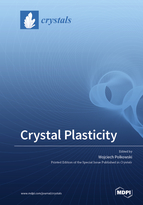Crystal Plasticity
A special issue of Crystals (ISSN 2073-4352). This special issue belongs to the section "Inorganic Crystalline Materials".
Deadline for manuscript submissions: closed (15 November 2020) | Viewed by 83107
Special Issue Editor
Interests: severe plastic deformation; plasticity; materials strengthening; solid/liquid interfacial phenomena; high temperature materials; intermetallics
Special Issues, Collections and Topics in MDPI journals
Special Issue Information
Dear Colleagues,
The term of “Crystal Plasticity” builds a bridge between pure crystallography, materials science, and industrial processing of commonly applied materials pieces (sheets, plates, wires, etc.).
As materials scientists and technologists working in the field of (poly)crystals plasticity, we all tend to provide valuable quantitative and qualitative indicators that describe the process→(crystalline) structure→properties relationship. Generally, our efforts are focused on recognizing possible ways to improve materials’ behavior under predicted operational conditions and applied mechanical and/or thermal external loadings. However, we all know that this goal can be achieved only by having well-established knowledge on crystal structure evolution regarding mechanical and plastic deformation processing.
Nowadays, the research on crystal plasticity-related phenomena is of high practical importance in the view of the following:
- The on-going progress in conventional fabrication techniques (as a forging or a cold rolling processes);
- The design of new processing methods (e.g., various complex severe plastic deformation techniques);
- The development of novel materials (e.g., high-entropy alloys, intermetallics, bulk metallic glasses, ultra-finegrained alloys, nano-steel, etc.).
In this regard, this Special Issue is especially dedicated to theoretical and experimental research works providing new insights and practical findings in the field of crystal plasticity-related topics. Potential papers include but are not limited to the following subjects, covering processing of modern functional and structural materials:
- Dislocation theory;
- Crystal lattice phase transformations and atomic reordering;
- Materials strengthening;
- Crystallographic texture changes;
- Materials processing;
- Microstructure evolution.
Dr. Wojciech Polkowski
Guest Editor
Manuscript Submission Information
Manuscripts should be submitted online at www.mdpi.com by registering and logging in to this website. Once you are registered, click here to go to the submission form. Manuscripts can be submitted until the deadline. All submissions that pass pre-check are peer-reviewed. Accepted papers will be published continuously in the journal (as soon as accepted) and will be listed together on the special issue website. Research articles, review articles as well as short communications are invited. For planned papers, a title and short abstract (about 100 words) can be sent to the Editorial Office for announcement on this website.
Submitted manuscripts should not have been published previously, nor be under consideration for publication elsewhere (except conference proceedings papers). All manuscripts are thoroughly refereed through a single-blind peer-review process. A guide for authors and other relevant information for submission of manuscripts is available on the Instructions for Authors page. Crystals is an international peer-reviewed open access monthly journal published by MDPI.
Please visit the Instructions for Authors page before submitting a manuscript. The Article Processing Charge (APC) for publication in this open access journal is 2600 CHF (Swiss Francs). Submitted papers should be well formatted and use good English. Authors may use MDPI's English editing service prior to publication or during author revisions.
Keywords
- Plasticity
- Crystallographic texture
- Severe plastic deformation
- Cold/hot plastic deformation processing
- Strengthening
- Metals and alloys
- Intermetallics
Related Special Issues
- Crystal Plasticity (Volume II) in Crystals (27 articles)
- Crystal Plasticity (Volume III) in Crystals (14 articles)






